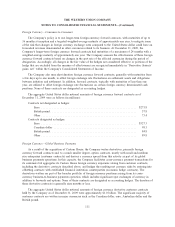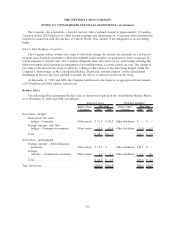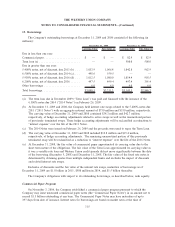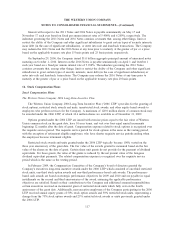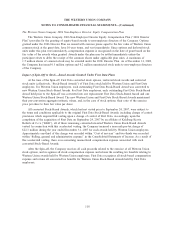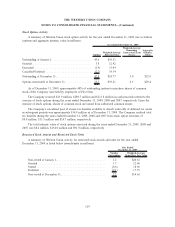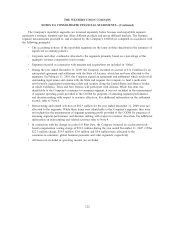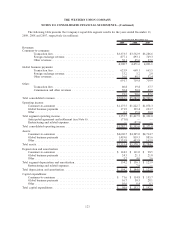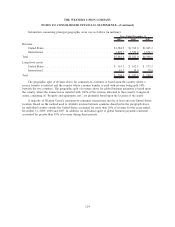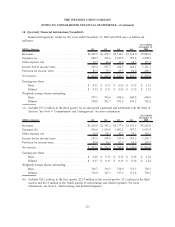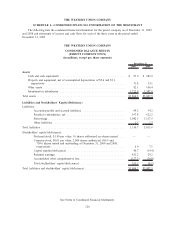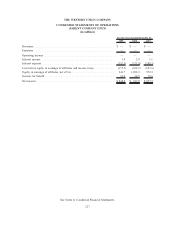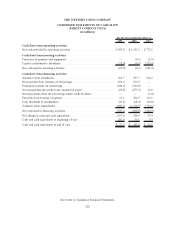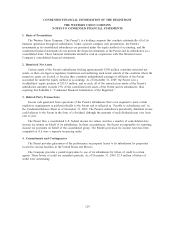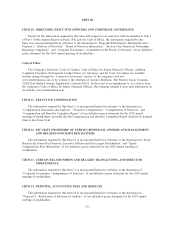Western Union 2009 Annual Report Download - page 135
Download and view the complete annual report
Please find page 135 of the 2009 Western Union annual report below. You can navigate through the pages in the report by either clicking on the pages listed below, or by using the keyword search tool below to find specific information within the annual report.respective grant date. The 2009 grants do not reflect the increase in dividends approved by the Board of
Directors on December 9, 2009 as all 2009 grants were issued prior to that date.
Expected term— For 2009, Western Union’s expected term was 5.0 years for non-executive employees
and 6.7 years for the board of directors and executives. For 2008 and 2007, Western Union’s expected term
was 5.8 years for non-executive employees and 7.5 years for the board of directors and executives. The
Company’s expected term of options was based upon, among other things, historical exercises (including the
exercise history of First Data’s awards), the vesting term of the Company’s options and the options’ contractual
term of ten years.
Risk-free interest rate—The risk-free rate for stock options granted during the period is determined by
using a United States Treasury rate for the period that coincided with the expected terms listed above.
The assumptions used to calculate the fair value of options granted will be evaluated and revised, as
necessary, to reflect market conditions and the Company’s historical experience and future expectations. The
calculated fair value is recognized as compensation cost in the Company’s financial statements over the
requisite service period of the entire award. Compensation cost is recognized only for those options expected
to vest, with forfeitures estimated at the date of grant and evaluated and adjusted periodically to reflect the
Company’s historical experience and future expectations. Any change in the forfeiture assumption will be
accounted for as a change in estimate, with the cumulative effect of the change on periods previously reported
being reflected in the financial statements of the period in which the change is made. In the future, as more
historical data is available to calculate the volatility of Western Union stock and the actual terms Western
Union employees hold options, expected volatility and expected term may change which could change the
grant-date fair value of future stock option awards and, ultimately, the recorded compensation expense.
17. Segments
As previously described in Note 1, the Company classifies its businesses into two reportable segments:
consumer-to-consumer and global business payments. Operating segments are defined as components of an
enterprise that engage in business activities, about which separate financial information is available that is
evaluated regularly by the Company’s chief operating decision maker (“CODM”) in deciding where to allocate
resources and in assessing performance.
The consumer-to-consumer reporting segment is viewed as one global network where a money transfer
can be sent from one location to another, anywhere in the world. The segment consists of three regions, which
primarily coordinate agent network management and marketing activities. The CODM makes decisions
regarding resource allocation and monitors performance based on specific corridors within and across these
regions, but also reviews total revenue and operating profit of each region. These regions frequently interact
on transactions with consumers and share processes, systems and licenses, thereby constituting one global
consumer-to-consumer money transfer network. The regions and corridors generally offer the same services
distributed by the same agent network, have the same types of customers, are subject to similar regulatory
requirements, are processed on the same system and have similar economic characteristics, allowing the
geographic regions to be aggregated into one reporting segment.
The global business payments (formerly consumer-to-business) segment processes payments from
consumers or businesses to other businesses. The results of the Company’s existing consumer-to-business
operations as well as the newly acquired Custom House business have been combined in this segment as both
are focused on facilitating payments. For further information on Custom House, see Note 3, “Acquisitions.”
All businesses that have not been classified into consumer-to-consumer or global business payments are
reported as “Other.” These businesses primarily include the Company’s money order services business.
121
THE WESTERN UNION COMPANY
NOTES TO CONSOLIDATED FINANCIAL STATEMENTS—(Continued)


